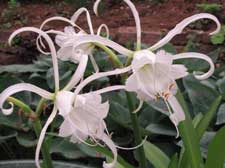Resource Library
Plant of the Week: Peruvian Daffodil
The University of Arkansas System Division of Agriculture does not promote, support or recommend plants featured in "Plant of the Week." Please consult your local Extension office for plants suitable for your region.
Plant of the Week
Peruvian Daffodil
Latin: Hymenocallis x festalis

The Peruvian daffodil is blooming in my garden. As I ponder its sweet fragrance and delicate pearly blooms, I remind myself that this plant is a gift from generations past. Who was it that brought this plant from its jungle home in far off Peru to my garden in Arkansas?
Peruvian daffodil (Hymenocallis x festalis) is a man-made hybrid of two of the 50 or so summer blooming bulbous plants that grow in warm temperate and tropical regions of North and South America. These plants have a variety of common names such as spider lily, basket flower, crown-beauty and sea daffodil.
In the southeastern states, the winter-hardy H. caroliniana is found growing here and there in wet, sunny places throughout the region. About 15 species are native in the United States. Like the true daffodil, Hymenocallis belongs to amaryllis family.
The Peruvian daffodil grows from an elongated bulb with linear, jade-green inch-wide leaves reaching 18 to 24 inches tall. The leaves appear before the flowers, which appear in early summer on scapes 24 to 30 inches high. From two to four white, spidery flowers with six slender reflexed petals back a 2-inch long and wide-frilled cup.
The blooms have a delicate but modest fragrance and are produced over about a two-week period.
Of the Hymenocallis in the bulb trade, this is the most commonly offered species. It was created as an artificial hybrid between H. narcissiflora as the female parent and H. longipetala as the pollen source. Both species are native to Peru. From its inception, the hybrid showed remarkable vigor and combined the most desirable characteristics of its parents.
The Hymenocallis have long had an identity crisis, and botanists have frequently changed their names. Even today, Peruvian daffodil is still sometimes listed as Ismene x festalis.
The hybrid cross was made about 1900 by Arthington Worsley (1861-1944), an English civil engineer with a keen interest in tender bulbs, especially amaryllis. Worsley traveled to the Caribbean and adjacent areas of tropical South America in 1893 and 1894, where he collected various bulbous plants of the amaryllis family and wrote a short monograph of his collection.
Over the years, Worsley’s name is associated with various breeding and taxonomic projects involving amaryllis. In 1934, he was one of the cofounders of the organization now known as the International Bulb Society. Fittingly, the blue amaryllis (Worsley procera) from southern Brazil was named to honor him.
Peruvian daffodils are hardy in milder areas, surviving as far north as zone 8. They do best in moist, sunny locations in full sun or light shade. Unlike most bulbs, winter-wet conditions aren’t a problem with this species. Bulbs increase quickly by offsets and should be divided every five years or so to keep the plants in bloom. Divide in late winter before new growth appears. In colder areas, the bulbs may be grown in large containers or transplanted into a prominent location for summertime blooming.
By: Gerald Klingaman, retired
Extension Horticulturist - Ornamentals
Extension News - June 19, 2009
The University of Arkansas System Division of Agriculture does not maintain lists of retail outlets where these plants can be purchased. Please check your local nursery or other retail outlets to ask about the availability of these plants for your growing area.